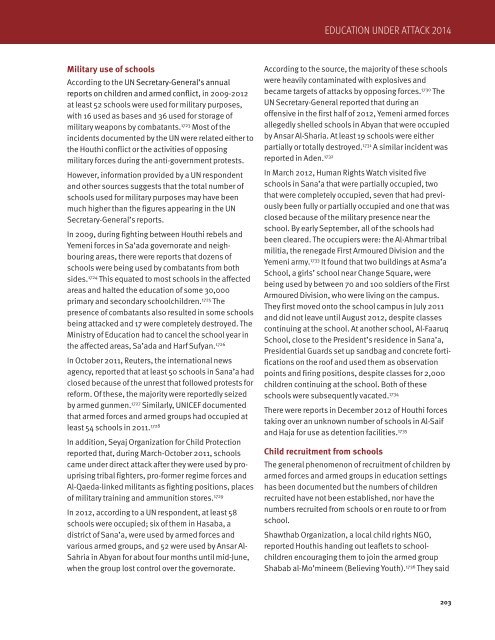Create successful ePaper yourself
Turn your PDF publications into a flip-book with our unique Google optimized e-Paper software.
EDUCATION UNDER ATTACK 2014<br />
Military use of schools<br />
According to the UN Secretary-General’s annual<br />
reports on children and armed conflict, in 2009-2012<br />
at least 52 schools were used for military purposes,<br />
with 16 used as bases and 36 used for storage of<br />
military weapons by combatants. 1723 Most of the<br />
incidents documented by the UN were related either to<br />
the Houthi conflict or the activities of opposing<br />
military forces during the anti-government protests.<br />
However, information provided by a UN respondent<br />
and other sources suggests that the total number of<br />
schools used for military purposes may have been<br />
much higher than the figures appearing in the UN<br />
Secretary-General’s reports.<br />
In 2009, during fighting between Houthi rebels and<br />
Yemeni forces in Sa’ada governorate and neighbouring<br />
areas, there were reports that dozens of<br />
schools were being used by combatants from both<br />
sides. 1724 This equated to most schools in the affected<br />
areas and halted the education of some 30,000<br />
primary and secondary schoolchildren. 1725 The<br />
presence of combatants also resulted in some schools<br />
being attacked and 17 were completely destroyed. The<br />
Ministry of Education had to cancel the school year in<br />
the affected areas, Sa’ada and Harf Sufyan. 1726<br />
In October 2011, Reuters, the international news<br />
agency, reported that at least 50 schools in Sana’a had<br />
closed because of the unrest that followed protests for<br />
reform. Of these, the majority were reportedly seized<br />
by armed gunmen. 1727 Similarly, UNICEF documented<br />
that armed forces and armed groups had occupied at<br />
least 54 schools in 2011. 1728<br />
In addition, Seyaj Organization for Child Protection<br />
reported that, during March-October 2011, schools<br />
came under direct attack after they were used by prouprising<br />
tribal fighters, pro-former regime forces and<br />
Al-Qaeda-linked militants as fighting positions, places<br />
of military training and ammunition stores. 1729<br />
In 2012, according to a UN respondent, at least 58<br />
schools were occupied; six of them in Hasaba, a<br />
district of Sana’a, were used by armed forces and<br />
various armed groups, and 52 were used by Ansar Al-<br />
Sahria in Abyan for about four months until mid-June,<br />
when the group lost control over the governorate.<br />
According to the source, the majority of these schools<br />
were heavily contaminated with explosives and<br />
became targets of attacks by opposing forces. 1730 The<br />
UN Secretary-General reported that during an<br />
offensive in the first half of 2012, Yemeni armed forces<br />
allegedly shelled schools in Abyan that were occupied<br />
by Ansar Al-Sharia. At least 19 schools were either<br />
partially or totally destroyed. 1731 A similar incident was<br />
reported in Aden. 1732<br />
In March 2012, Human Rights Watch visited five<br />
schools in Sana’a that were partially occupied, two<br />
that were completely occupied, seven that had previously<br />
been fully or partially occupied and one that was<br />
closed because of the military presence near the<br />
school. By early September, all of the schools had<br />
been cleared. The occupiers were: the Al-Ahmar tribal<br />
militia, the renegade First Armoured Division and the<br />
Yemeni army. 1733 It found that two buildings at Asma’a<br />
School, a girls’ school near Change Square, were<br />
being used by between 70 and 100 soldiers of the First<br />
Armoured Division, who were living on the campus.<br />
They first moved onto the school campus in July 2011<br />
and did not leave until August 2012, despite classes<br />
continuing at the school. At another school, Al-Faaruq<br />
School, close to the President’s residence in Sana’a,<br />
Presidential Guards set up sandbag and concrete fortifications<br />
on the roof and used them as observation<br />
points and firing positions, despite classes for 2,000<br />
children continuing at the school. Both of these<br />
schools were subsequently vacated. 1734<br />
There were reports in December 2012 of Houthi forces<br />
taking over an unknown number of schools in Al-Saif<br />
and Haja for use as detention facilities. 1735<br />
Child recruitment from schools<br />
The general phenomenon of recruitment of children by<br />
armed forces and armed groups in education settings<br />
has been documented but the numbers of children<br />
recruited have not been established, nor have the<br />
numbers recruited from schools or en route to or from<br />
school.<br />
Shawthab Organization, a local child rights NGO,<br />
reported Houthis handing out leaflets to schoolchildren<br />
encouraging them to join the armed group<br />
Shabab al-Mo’mineem (Believing Youth). 1736 They said<br />
203


